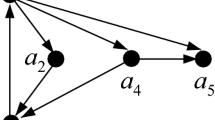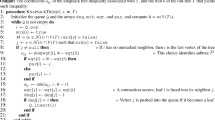Abstract
In this paper, the set partitioning problem is reformulated as a network flow problemwith special order sets. The reformulation is based on identifying network structure that ishidden in the element-set incidence matrix. The special order sets and the revealed networkin the reformulation together define an effective structure for solution by enumeration. Theresulting enumeration procedure for the solution of the set partitioning problem is computationallyadvantageous since it uses a pure network relaxation that is solved using reoptimization,allows a large number of variables to be fixed in a subproblem, and is defined overa relatively small enumeration tree. Computational experience is included.
Similar content being viewed by others
References
A.I. Ali and H. Han, Computational implementation of Fujishige's graph realizability algorithm, European Journal of Operational Research (1994).
A.I. Ali and H. Han, Extracting hidden network submatrices of a (0, 1) matrix using a PQ-graph, Working Paper, School of Management, University of Massachusetts at Amherst, 1994.
A.I. Ali, R. Padman and H. Thiagarajan, Dual algorithms for pure network problems, Operations Research 37(1989)159–171.
A.I. Ali and H. Thiagarajan, A network relaxtion based enumeration algorithm for set partitioning, European Journal of Operational Research 38(1989)76 –89.
A. Avis, A note on some computationally difficult set covering problems, Mathematical Programming 18(1980)135–143.
E. Balas and M.W. Padberg, Set partitioning–a survey, in: Combinatorial Optimization, eds. N. Christofides, P. Mingozzi, P. Toth and C. Sandi, Wiley, Chichester, England.
J. Bartholdi, A good submatrix is hard to find, Operations Research Letters 1(1982)190–193.
R.E. Bixby and R. Fourer, Finding embedded network rows in linear programs, I. Extraction heuristics, Management Science 34(1988)342–376.
G.G. Brown and D. Thomen, Automatic identification of generalized upper bounds in large-scale optimization models, Management Science 26(1980)1166–1184.
G.G. Brown, R.D. McBride and R.K. Wood, Extracting embedded generalized networks from linear programming problems, Mathematical Programming 32(1985)11–31.
G.G. Brown and W.G. Wright, Automatic identification of embedded network rows in large-scale optimization models, Mathematical Programming 29(1984)41–46.
T.J. Chan and C.A. Yano, A multiplier adjustment approach for the set partitioning problem, Operations Research 40, Supp. 1(1992)S40–S47.
J. Etcheberry, The set-covering problem: A new implicit enumeration algorithm, Operations Research 25(1977)760–772.
E. El-Darzi and G. Mitra, Solution of set covering and set partitioning problems using assignment relaxations, Journal of the Operational Research Society 43(1992)483–493.
E. El-Darzi and G. Mitra, Graph-theoretic relaxations of set covering and set partitioning problems, European Journal of Operational Research 87(1995)109–121.
M. Fisher and P. Kedia, Optimal solution of set covering/partitioning problems using dual heuristics, Management Science 36(1990)674–688.
S. Fujishige, An efficient PQ-graph algorithm for solving the graph realization problems, Journal of Computer and System Sciences 21(1980)63–86.
G. Graves, R. McBride, I. Gershkoff, D. Anderson and D. Mahidhara, Flight crew scheduling, Management Science 39(1993736–745.
G. Gunawardane, S. Hoff and L. Schrage, Identification of special structure constraints in linear programs, Mathematical Programming 21(1981)90–97.
H. Han, Algorithms to extract hidden networks and applications to set partitioning problems, unpublished Dissertation, School of Management, The University of Massachusetts at Amherst, 1994.
K.L. Hoffman and M. Padberg, Solving airline crew-scheduling problems by branch and cut, Management Science 39(1993)657–682.
C.E. Lemke, H.M. Salkin and K. Spielberg, Set covering problem by single branch enumeration with linear programming subproblems, Operations Research 19(1971)998–1022.
R.E. Marsten, An algorithm for large set partitioning problems, Management Science 20(1974)191–209.
G.L. Nemhauser and G.L. Weber, Optimal set partitionings and Lagrangean duality, Naval Research Logistics Quarterly 26(1979)553–563.
M.W. Padberg, On the facial structure of set packing polyhedra, Mathematical Programming 5(1973)199–215.
F. Shepardson and R.E. Marsten, A Lagrangean relaxation algorithm for the two duty period scheduling problem, Management Science 26(1980)274–281.
Rights and permissions
About this article
Cite this article
Iqbal Ali, A. Reformulation of the set partitioning problem as apure network with special order set constraints. Annals of Operations Research 81, 233–250 (1998). https://doi.org/10.1023/A:1018953006796
Issue Date:
DOI: https://doi.org/10.1023/A:1018953006796




